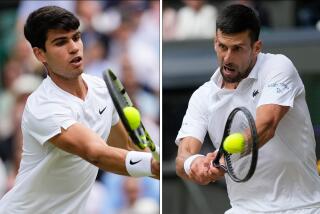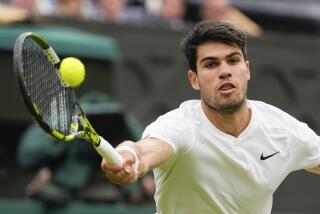COMMENTARY : Tennis Like This Isn’t Easy to Hack
WIMBLEDON, England — Mostly, I blame Nick Bollettieri, and I don’t even know Nick Bollettieri.
I blame him and all those sporting goods companies that make all those super-duper extra-strength graphite rocket launchers that they call tennis rackets.
I probably wouldn’t be thinking these things, wouldn’t have time. But it’s raining again at Wimbledon, and when the rains come, so does time for pondering.
Surprisingly, what I’ve seen has been fairly disappointing--the tennis and the players, that is, not the rain. Rain is just rain. You can’t do anything about that. But the tennis? That’s worth dissecting.
John McEnroe lost Tuesday in one of the few matches they got in before play was stopped. He lost to Stefan Edberg, a 25-year-old Swede who is currently the No. 1 player in the world.
There was quite a bit of anticipation, even though Edberg is seeded No. 1 and McEnroe No. 16. The hope was that somehow the McEnroe genius and mastery would reappear, that the softest hands ever to hold a tennis racket would somehow be competitive against the robot-like precision of the larger, faster, stronger Edberg.
But McEnroe is 32, and even though there were hints and glints of the past, the sad truth is that he never had a chance.
In fact, the sad truth is that age and strength and technology now rule this game.
It’s all over for McEnroe and Jimmy Connors and Yannick Noah and Henri Leconte, as well as for Pam Shriver and, in a very short time, Martina Navratilova. They represent an era of personalities and athletes who have, in so many ways, brought the game to whatever degree of greatness it holds today.
They will play some more, even have some success. But they are too old to win the big ones now. Despite being young in terms of our general society, they are well beyond being capable of coping with the youth and technology thrown at them daily in the form of 115-m.p.h. serves and bullet ground strokes.
Yes, that even applies to Navratilova, who has won nine times at Wimbledon, is 34, has had knee surgery and, when the rains came Tuesday, was a set down to a 15-year-old named Jennifer Capriati, who hits the tennis ball like Arnold Schwarzenegger.
Where have you gone, (Jimmy Connors ) ? A nation turns its lonely eyes to you.
--Paul Simon, “Mrs. Robinson.”
Tennis appears to be a sport badly in need of a personality.
So far, Connors and McEnroe have been the stars at Wimbledon, and neither of them had a chance to win. But they are the stars because the press and the public need something of quality to feed off, to recognize, to relate to.
Connors and McEnroe, once considered the brats of tennis, have become adults in a sport dominated by robotic children.
A thoughtful player such as Boris Becker is an exception in a game filled with the byproducts of tennis academy boot camps such as Bollettieri’s in Bradenton, Fla., where they seem to learn to hit and run and get strong and fast, but little more.
Certainly, that is a generalization, but it is the impression left.
And the question remains, who in the next generation will offer the insight that Connors and McEnroe have?
David Wheaton, a nice young man from Minneapolis who won his way into the quarterfinals Tuesday, was asked Monday after posting a major upset victory over Ivan Lendl, if it had been his biggest yet? The answer appeared obvious. He had just beaten one of the legends of the game, on Centre Court, at Wimbledon. How much better does it get than that?
Wheaton’s answer was that it ranked up there with his victory over Edberg “at the Lipton.”
This is Wimbledon. This is a World Series in Fenway Park, a British Open at St. Andrews and a Stanley Cup seventh game in the Montreal Forum all lumped into one. And this young man wants to liken it to something he did at some stop along the way in Florida.
It’s not his fault, really. He is the product of an era of tennis players who are, in so many ways, living the old sportswriters’ theory about Olympic swimmers, which held that they were able to communicate intelligently about very little because they hit their heads on the wall so many times while doing laps.
Bollettieri, of course, is an easy target, probably unfairly accused here.
It is just that it seems as if he is some kind of Pied Piper of the current generation of two-handed backhand-slugging children, who move like migrants from one city to the next and very infrequently utter, or are able to utter, a thoughtful paragraph.
So many seem to be blessed with weight-trained athleticism, programmed with winning drive and devoid of personality.
Bollettieri’s most famous prodigy, Andre Agassi, seems to be not so much a personality as a walking sales campaign.
Jack Kramer once said: “I was proud it had my name on it, because there was nothing quite like the old Wilson Kramer racket; the way it felt, the way it played.”
Sure, it’s stupid to lament the passing of the old wooden tennis racket. The new ones don’t hurt your arm as much, do more on their own and have certainly improved the game in just about every way.
But watching here on a steady basis gives cause for pause.
Every match, especially on the men’s side, appears to be merely a test of who can hit the ball harder. Each match has a rhythm: Wham, big serve . . . whack, big return . . . crunch, point-ending volley. It’s a kind of a tennis three-step waltz, and, quite frankly, it can get kind of boring.
Remember Bjorn Borg and McEnroe in 1980? Plenty of serving and volleying, but so much more than just slam-bang.
And with wood rackets, no less.
McEnroe was asked after his match Tuesday: “Can we say the quality of tennis on grass is decreasing because of the power game?”
He answered: “It’s not that it’s decreasing. If a guy is hitting a serve 120 m.p.h. at you and he hits it into the corner, it’s pretty hard to consistently do a lot with that.”
Indeed, tennis appears to be, currently, a sport marketing itself to adults, when its main salable product is children who play with rocket launchers.
That obviously sells lots of rackets.
But tickets and TV rights, the real areas of need for the growth of the sport? Perhaps not.
McENROE FALLS: Top-seeded Stefan Edberg wasted no time as he overpowered 32-year-old John McEnroe in three sets. C12
More to Read
Go beyond the scoreboard
Get the latest on L.A.'s teams in the daily Sports Report newsletter.
You may occasionally receive promotional content from the Los Angeles Times.











